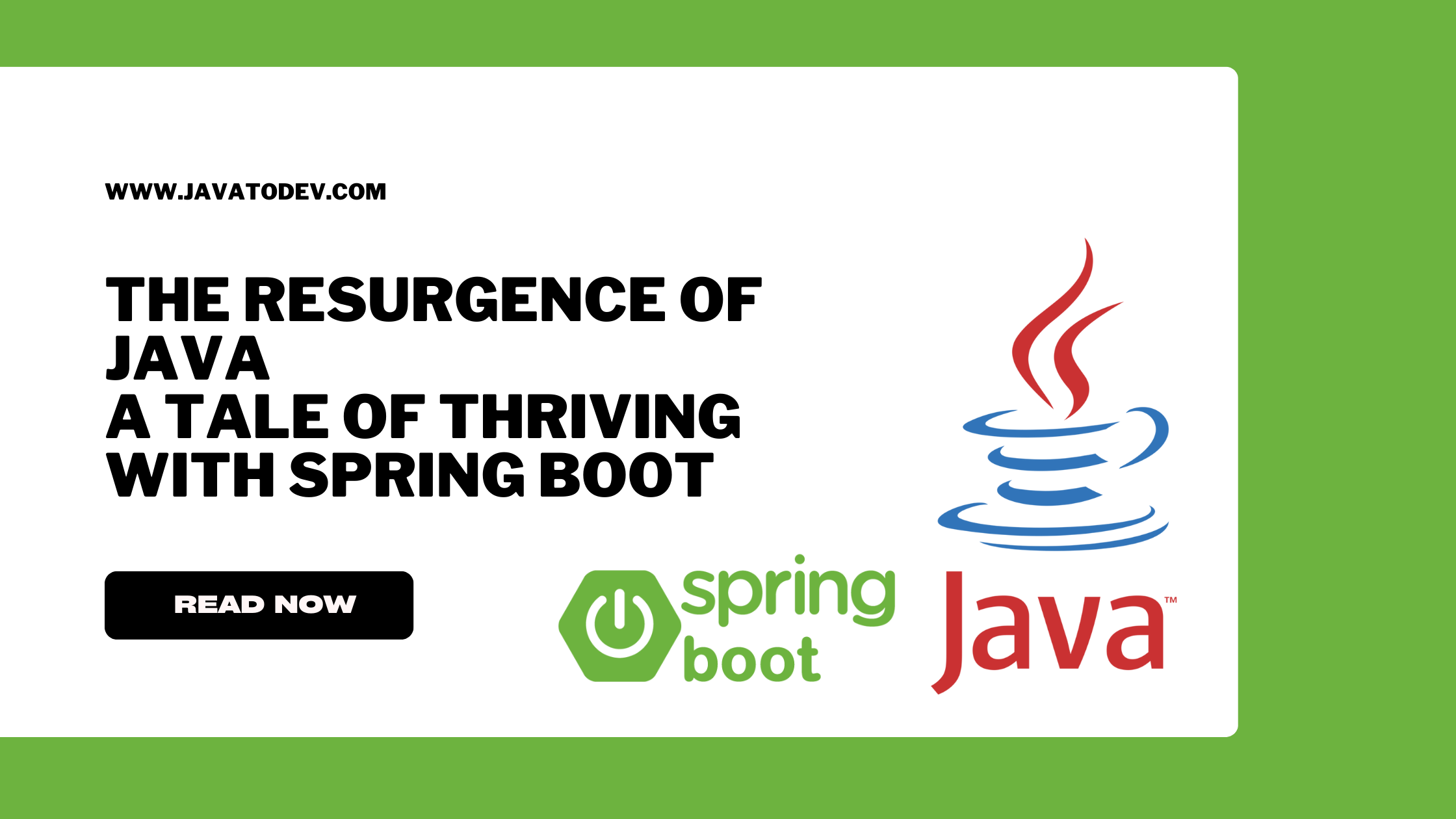The Resurgence of Java: A Tale of Thriving with Spring Boot
-
 Chinthaka Dinadasa
Chinthaka Dinadasa - 01 Aug, 2023

Have you ever wondered how Java, one of the oldest programming languages, managed to stay relevant and even thrive in today’s fast-paced tech world? Well, the secret lies in Spring Boot, a powerful framework that breathed new life into Java development.
In this revised topic, the focus is on the resurgence of Java, highlighting how Spring Boot played a pivotal role in its success. The article will delve into the various factors that contributed to Java’s continued relevance in modern times and its adaptability to new trends and technologies.
The synergy with Spring Boot, the rise of microservices, and embracing cloud-native development are key themes that will be explored, offering readers valuable insights into the world of Java development in today’s rapidly changing tech landscape.
Whether you’re a seasoned developer or just starting your coding journey, this article will shed light on the significance of Spring Boot and why it’s a game-changer for Java enthusiasts.
1. The Rise and Fall of Java
Java’s Ascendancy
Java, originally released in 1995, quickly became a dominant force in the software development industry. Its “write once, run anywhere” (WORA) principle revolutionized cross-platform compatibility, making it a popular choice for building web and mobile applications.
Challenges Faced by Java
Over the years, Java faced fierce competition from newer languages and frameworks, and critics claimed that it was becoming too verbose and rigid for modern development needs. The community sought ways to revitalize the language and make it more agile and developer-friendly.
2. The Birth of Spring Boot
What is Spring Boot?
Enter Spring Boot, an open-source framework built on top of the Spring framework. Spring Boot aimed to simplify Java application development by providing a convention-over-configuration approach. It took care of boilerplate configurations, allowing developers to focus on writing business logic.
A Breath of Fresh Air
With Spring Boot arrival in 2014, Java developers found a new ray of hope. The framework’s auto-configuration and starter dependencies drastically reduced the development time and made it easier for developers to bootstrap projects quickly.
3. The Synergy of Java and Spring Boot
Streamlining Java Development
Spring Boot’s seamless integration with Java led to a perfect marriage of the two technologies. It streamlined Java development, making it more productive and enjoyable.
Embracing Convention Over Configuration
The convention-over-configuration principle embraced by Spring Boot eliminated the need for extensive XML configurations and annotations. Developers could now focus on writing code rather than spending time on boilerplate setup.
4. Unleashing the Power of Microservices
The Microservices Revolution
In recent years, microservices architecture gained immense popularity due to its scalability and flexibility. Spring Boot proved to be an ideal choice for building microservices due to its lightweight and modular design.
Checkout our free course on Building microservices with spring boot
Simplifying Microservices Development
Java developers found that Spring Boot facilitated the development of microservices with its inherent support for building RESTful APIs, handling configuration, and managing dependencies. This made it easier to create complex systems without getting entangled in intricate details.
5. Community and Ecosystem Support
Thriving Community
Spring Boot’s success can be attributed in large part to its vibrant and active community. Developers worldwide contribute to the framework, continually enhancing its features and fixing bugs.
Expanding Ecosystem
The Spring Boot ecosystem extends beyond the core framework, offering a wide range of plugins, libraries, and tools that complement Java development. This expansive ecosystem ensures that developers have everything they need at their disposal.
6. Embracing Cloud-Native Development
Adaptability in the Cloud Era
As cloud computing became mainstream, Java and Spring Boot adapted seamlessly to this new paradigm. Spring Boot support for cloud-native development, coupled with Java’s platform independence, made it a preferred choice for cloud-based applications.
Building Resilient Applications
With Spring Boot capabilities for handling fault tolerance and its integration with cloud platforms, developers could build robust and reliable applications in the cloud.
7. Staying Relevant in Modern Times
Continuous Evolution
One of the key reasons Java survived with Spring Boot is the commitment to continuous improvement. Both Java and Spring Boot have stayed relevant by embracing new technologies and incorporating modern practices.
Future Outlook
Looking ahead, Java’s journey with Spring Boot seems promising. As the tech landscape evolves, both technologies are well-equipped to adapt and thrive in the ever-changing world of software development.
Conclusion
In conclusion, the partnership between Java and Spring Boot has been nothing short of extraordinary. Spring Boot breathed new life into Java, addressing its challenges and providing developers with a robust and efficient framework. Together, they have not only survived but thrived in the dynamic tech landscape.
FAQs
Q1: Is Spring Boot suitable for beginners? Yes, Spring Boot’s simplicity and convention-over-configuration approach make it beginner-friendly and a great choice for developers starting with Java.
Q2: Can I use Spring Boot with other programming languages? Spring Boot is primarily designed for Java development, but some community projects allow integration with other languages like Kotlin and Groovy.
Q3: Does Spring Boot support microservices deployment in the cloud? Absolutely! Spring Boot cloud-native features make it a popular choice for deploying microservices in cloud environments.
Q4: Are there any performance concerns with Spring Boot? Spring Boot performance is generally excellent, but like any framework, it’s essential to optimize your application code for optimal results.
Q5: Does Spring Boot replace the Spring framework entirely? No, Spring Boot builds upon the Spring framework and simplifies its configuration. It is meant to be an extension, not a replacement.


